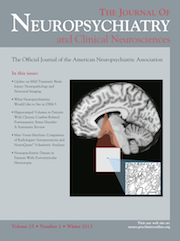Risk of Akathisia Associated With Atypical Antipsychotics
To the Editor: Akathisia is an extrapyramidal symptom (EPS) that is characterized by an objective inability to sit or stand still and by a subjective feeling of inner restlessness.1 It was first described by Haskovec, who linked symptoms of akathisia to dopamine receptor blockade in nigrostriatal regions of the brain.1 It can present as a diagnostic and treatment challenge affecting the management of primary conditions. Furthermore, akathisia is associated with significant distress, and has been linked to aggression, violence, suicidality, insomnia, exacerbation of psychotic illness, tardive dyskinesia, and poor adherence to treatment.2,3
We report two cases where the side effects of akathisia developed in the context of adding an atypical antipsychotic medication and polypharmacy.
Case Report #1
A 25-year-old Caucasian man with schizoaffective disorder was maintained on risperidone (5.5 mg), aripiprazole (15 mg), and lithium (1,200 mg). His symptoms included thought disorganization, obsessive and intrusive thoughts with magical thinking, paranoid ideations, and visual hallucinations with graphic presentation of hurting his family. Asenapine was started as an augmenting agent at 5 mg sublingually twice a day after lack of clinical efficacy with aripiprazole and the patient’s refusal to increase risperidone because of its sexual side effects. Within a few days, he complained of severe restlessness, anxiety with panic-like symptoms, irritability, pacing around for hours, and inability to sit still. The Barnes Akathisia scale score was 10 out of a possible 14 points. Treatment with low-dose lorazepam or benztropine was not effective. Because of persistent symptoms, despite discontinuation of aripiprazole, it was decided to taper off asenapine, and akathisia symptoms resolved soon after the discontinuation of asenapine.
Case Report #2
A 30-year-old Caucasian man with schizophrenia was maintained on quetiapine (450 mg) and aripiprazole (25 mg), Lexapro (20 mg), clonazepam (3 mg), and buspirone (30 mg). Asenapine 5 mg bid sublingually was started as augmentation for persistent thought disorder, paranoia, and mood instability. Within 3 days of starting asenapine, he complained of severe motor restlessness, inability to stand still, irresistible urge to move, and difficulty falling asleep, despite taking clonazepam. The Barnes Akathisia scale score was 9 out of 14 points. Asenapine was decreased to 5 mg daily and discontinued after 7 days of treatment. The patient reported a decrease in akathisia soon after stopping asenapine.
Discussion
The differential diagnosis in these cases would include few conditions. Absence of mood symptoms, including irritability, and lack of response to anxiolytics rules out exacerbation of anxiety. Minimal changes in thought disorganization or paranoia exclude exacerbation of psychosis. Myoclonic jerks involving the legs have been described in restless-leg syndrome. However RLS and PMLD occur mainly at night.
The pathophysiology of akathisia is not clearly understood. Besides nigrostriatal dopamine blockade, serotonin (5 HT2A) receptors in the prefrontal cortex as well as mesolimbic and tuberoinfuldibular pathway modulate the extent of dopamine release and counteract some of the D2 blockade. This may explain why atypical antipsychotics cause less akathisia than typical antipsychotics.
Asenapine is an atypical antipsychotic with receptor profile including dopamine, serotonin, norepinephrine, and histamine-receptor subtypes.4 In clinical trials, it was found that asenapine’s affinity for 5 HT2A is 19 times higher than D2 receptors.5 However, therapeutic doses of asenapine (5 mg and 10 mg) still lead to 75%–85% of D2 receptor occupancy6 Although it is difficult to predict a direct causal relationship, our patients developed akathisia soon after asenapine was added. It could be argued that they were also treated with other atypical antipsychotics.
In clinical trials, aripiprazole-induced akathisia is significantly higher than placebo.7 Aripiprazole’s partial agonism at D2 and 5 HTIA protects against extrapyramidal symptoms but not against akathisia.8 Therefore, a sufficient degree of the 5-HT2A antagonism and a high 5-HT2A-to-D2 occupancy seems to be protective against akathisia.
Although it is plausible that asenapine could increase risk of akathisia, pharmacodynamic interactions among antipsychotics or cumulative dose-dependent effects leading to akathisia cannot be ruled out. Clinical approaches as starting with low dose, preventing polypharmacy, and vigorous treatment of akathisia are essential.
1 : Barnes The Barnes Akathisia Rating Scale−Revisited. J Psychopharmacol 2003; Dec.17 (4):365–370Google Scholar
2 : prevalence and associated dysphoria in an inpatient population with acute schizophrenia. Br J Psychiatry1994; 164:(177–183) 7: 365Google Scholar
3 Suicidal attempts associated with akathisia. Am J Psychiatry 1985; 142:46Google Scholar
4 : Asenapine elevates cortical dopamine, noradrenaline, and serotonin release: evidence for activation of cortical and subcortical dopamine systems by different mechanisms. Psychopharmacology (Berl) 2009; 204:251–264Crossref, Medline, Google Scholar
5 : Evaluation of the clinical efficacy of asenapine in schizophrenia. Expert Opin Pharmacother 2010; 11:2107–2115Crossref, Medline, Google Scholar
6 Asenapinemonograph; http://www.pbm.va.gov/Clinical%20Guidance/Drug%20Monographs/Asenapine%20Monograph.docGoogle Scholar
7 : Evaluation of akathisia in patients with schizophrenia, schizoaffective disorder, or bipolar I disorder: a post-hoc analysis of pooled data from short- and long-term aripiprazole trials. J Psychopharmacol 2010; 24:1019–1029Crossref, Medline, Google Scholar
8 : Aripiprazole: pharmacology, efficacy, safety, and tolerability. Expert Rev Neurother 2005; 5:297–307Crossref, Medline, Google Scholar



